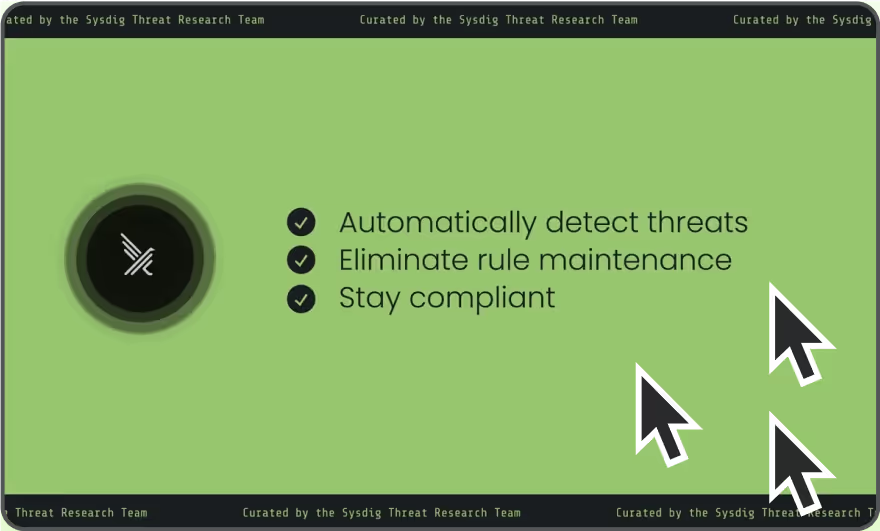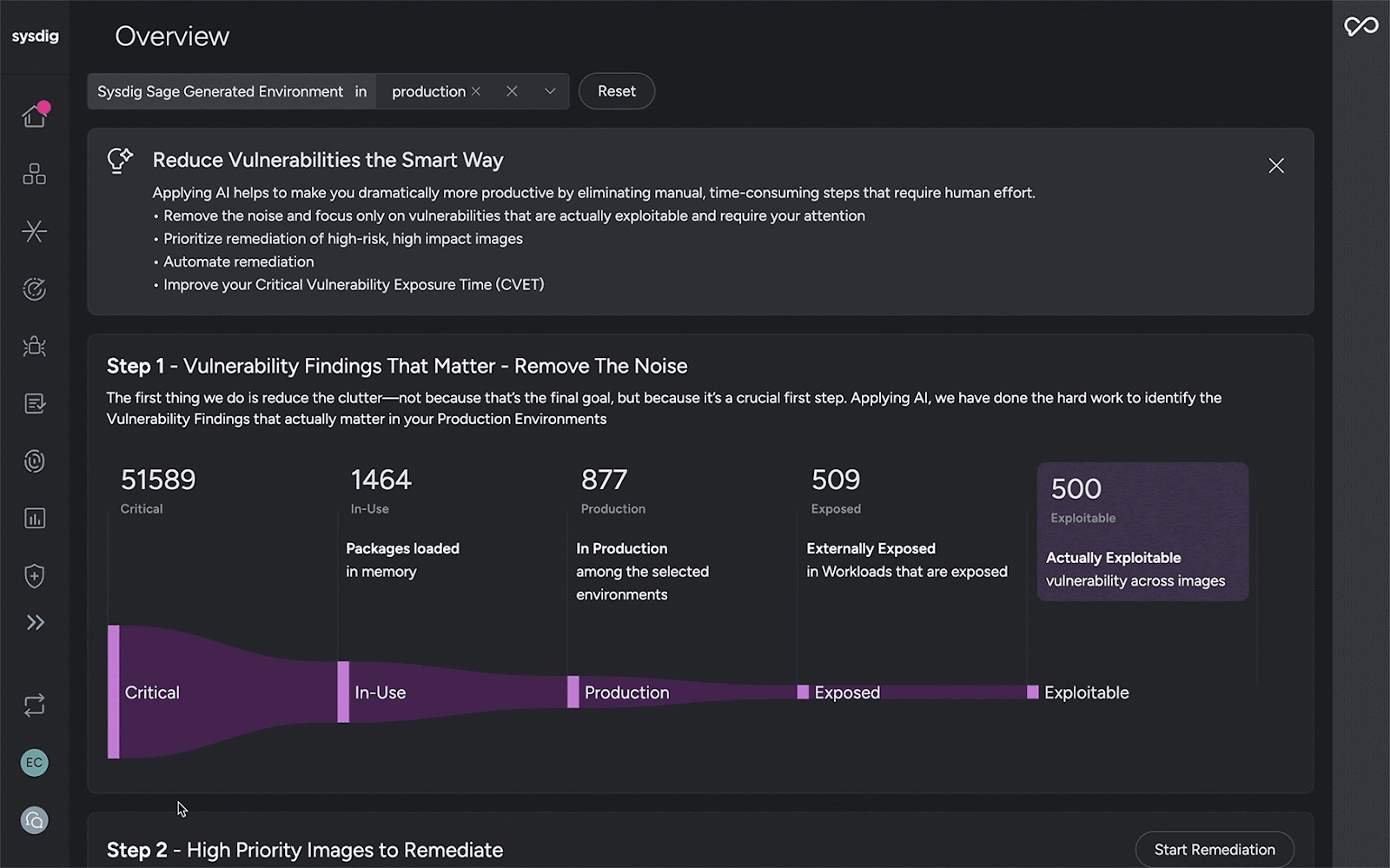
Falco Feeds extends the power of Falco by giving open source-focused companies access to expert-written rules that are continuously updated as new threats are discovered.

Keeping up with cloud security has never been harder. That’s why organizations are now looking to modern, agentic AI solutions to relieve the pressure on teams that are stretched thin. There has been tremendous innovation in cloud security over the past few years, however, many tasks remain time-consuming and require a judgment call regarding relevance and risk.
That’s where agentic AI comes in. As models become more capable of reasoning, learning, and acting — almost like humans — a new era is emerging. As a proactive problem-solver, agentic AI can be set on a mission to autonomously plan and execute tasks to achieve goals. Instead of just analyzing or regurgitating information, it can reason over information, interpret context, and make decisions with nuance and speed.
At Sysdig, we believe cloud security is a great use case for agentic AI. With the right direction, it is able to transform how we filter through tons of data, gain valuable context, and protect our cloud estates.
AI – from copilot to teammate
Generative AI assistance, in the form of a chat “copilot,” remains a valuable resource for cybersecurity analysts. Copilots, however, expect a human to prompt AI for assistance when needed. In contrast, agentic AI can be put into action and works around the clock to take initiative independently.
In many ways, it can be like hiring a great analyst – one who is ready to dig right in to whatever is needed. What this means for cloud security is that we can leverage agentic AI in some of the particularly challenging and perhaps tedious areas of cloud security, freeing staff to work on higher-scale problems. In this way, agentic AI is able to augment human analysts and multiply their impact.

The possibilities for agentic AI to assist security teams are wide and varied, including use cases such as:
- Augment threat detection and response: Monitor behavior in real-time, detect anomalies, and automate response actions to contain and neutralize threats.
- Assist vulnerability assessment and remediation: scan systems and workloads for weaknesses, assess their impact, and help prioritize and recommend remediation efforts.
- Automate security operations: Handle routine tasks, allowing human experts to focus on high-level investigations and strategic planning.
- Enhance posture management: Monitor complex cloud ecosystems, alert on misconfigurations, provide a continuous feedback loop, and adjusting controls in real-time
This list is just scratching the surface. With agentic AI, it seems the only limit is our imagination and willingness to engage the technology.
Connecting the dots across security data and domains
Dealing with all the signals and alerts coming in from security tooling is challenging for security teams, particularly if the tools are siloed. Cloud risks rarely exist in silos. A misconfigured permission here and a vulnerable image there can combine into a real breach pathway. Dynamic clouds keep teams busy sorting through these issues week in and week out.
Agentic AI brings reasoning power that can interpret and understand relationships across a massive volume of cloud security data. By continuously analyzing diverse data to map connections and distill insights into actionable intelligence, agentic AI can help build a useful narrative to better understand weaknesses. By tapping in to all of the latest threat intel and vulnerability information, It can also deliver guided, contextual remediation that helps teams understand how to respond to issues and address root cause(s).
Reasoning over business risk
One of the big jobs security teams must do is to decide what issues should be tackled first. Understanding sensitive assets and the business risks they pose is crucial for prioritizing the right things correctly. If there’s a lack of confidence, teams might focus on the wrong things or move slowly, hoping to gain some clarity along the way.
Organizations spend a lot of time, money, and effort mapping technical assets to the business services they support. It’s one of the key reasons why configuration management databases (CMDBs) exist. However, things move so quickly in the cloud, especially with environments that leverage cloud-native containers and Kubernetes, that the process can be error-prone, time-consuming, manual, and elusive.
Agentic AI helps solve this problem with the ability to analyze your environments to perform semantic analysis, interpreting business context. In cloud security, context is everything—knowing where an issue occurs, who’s involved, and what’s at stake. Help from AI agents move teams beyond technical signals, identifying business-critical assets, production systems, app types, and customer resources. The result is automated filtering and smart prioritization that augments human judgment to accelerate focus on the risks that truly threaten the business.
From insight to action
The true value of AI isn’t what it knows — it’s what it can help teams do. One of the opportunities for agentic AI in cloud security is to shift from a reactive to a proactive model by enabling AI to autonomously deploy countermeasures to contain and neutralize threats before they escalate.
For a moment, let’s acknowledge the elephant in the room - can we trust AI? Certainly, trust is, and will continue to be, an important consideration. What if AI makes the wrong call? What if it disrupts critical infrastructure? At Sysdig, we see it as a trust-building journey. Trust will be built gradually, starting with human-in-the-loop oversight and expanding as we experience outcomes and see a track record of reliability. In the meantime, agentic AI is able to help security teams increase their effectiveness by providing step-by-step, context-aware guidance, notifying relevant teams, and integrating with ticketing and workflow tooling.
Sysdig’s Agentic AI Approach
With Sysdig Sage™, our AI cloud security analyst, Sysdig has helped security teams investigate, respond, and reduce risk across the cloud security lifecycle. We’ve moved now into agentic cloud security, introducing autonomous agents that analyze your environment, understand your business, and take action with minimal human effort – starting with vulnerability management as the first use case.

At Sysdig, we believe AI for cloud security must be grounded in the uncompromising truth of runtime. AI is only as good as the signals it sees. Runtime signals provide an accurate view of what’s really happening in your environment. Extending data access with technologies like MCP help broaden the awareness and insights available to AI agents. Combining agentic reasoning, open innovation, and domain expertise helps teams understand, prioritize, and resolve risks faster.
A smarter and faster future for cloud defense
Agentic AI marks a shift from reactive to responsive, from manual to autonomous, from overwhelmed to empowered. It’s the next leap in defending the cloud — a system that doesn’t just alert you to danger but helps you understand and eliminate it.
Security expertise is scarce, and the cloud has only expanded the need for it. The future of security will be built on human-AI teamwork: tireless automation guided by human judgment, with AI that adapts to your environment, your risks, and your goals.
Ready to learn more? Download the Agentic AI For Cloud Security Checklist.


